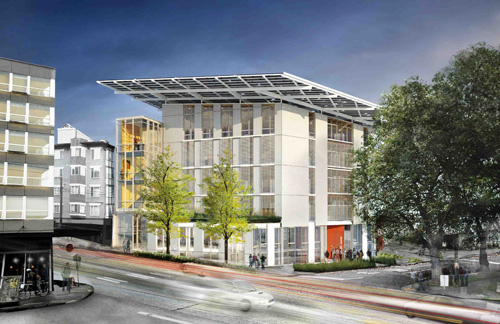
In a famous ad, Apple asked people to "Think Different." We are now at a point in the natural history of the planet when it is essential to act different. There is no better time to begin than on Earth Day.
In 1970, the first Earth Day led to sweeping changes in public policy. It created a new constituency that demanded the Clean Air Act and the Clean Water Act to protect public health, and the Endangered Species Act to protect other living things.
In 2012, with the most polarized Congress in history, vital national legislation cannot even get a hearing. Consequently, the greatest immediate environmental opportunities today do not involve Washington, DC. They involve smart, sustainable choices by the private sector, states and cities, and individuals.
A good place to start is real estate.
Irrational real estate prices, combined with fraudulent derivatives, shaky mortgages and an over-leveraged banking sector, produced the latest economic bubble. Like every other bubble, it popped. Property values plummeted, new construction stopped, and investors sat on the sidelines.
Now that our devastated economy is finally showing signs of recovery, developers andbanks are starting once again to contemplate new real estate investments. Will we go back to business-as-usual, with the same risks and costs? Or will we act different?
In Seattle, we are doing things differently in a new office building known as the Bullitt Center. With a mix of vision and pragmatism, our goal is to do everything right.
What does "do everything right" mean?
A typical new office building has a design life of 40 years. The core of the Bullitt Center has a design life of 250 years.
In a typical office, windows are sealed shut while fossil fuels battle the summer heat and winter chill. By contrast, the Bullitt Center has a super-efficient shell. The windows automatically open when appropriate to allow Seattle's temperate breezes in. And geothermal heat pumps use the constant temperature of the Earth to increase the efficiency of thetiny heating and cooling system. It will use about one-fifth as much energy as an average building its size.
In fact, the Bullitt Center is so efficient that the 240-kilowatt array on its roof will generate enough electricity to meet 100 percent of its yearly needs, even in cloud-covered Seattle.

The Bullitt Center
If an audacious entirely solar-powered six-story building is possible in Seattle, what's possible across the U.S.? According to estimates from the U.S. Energy Information Administration, there are more than 481 square miles of roof available for solar in the U.S. If this area were covered with photovoltaic arrays, we could accommodate more than 700,000 megawatts of clean, renewable power, which is almost 75 percent of total electricity generation capacity in the U.S.
The Bullitt Center will also capture and treat the rain that falls on its roof, storing it in a 56,000-gallon cistern in the basement for months when it doesn't rain. Eventually, we will gain permission to use rainwater for all purposes, including drinking.
While Seattle is more blessed with rain than some other cities, we receive less total precipitation than Atlanta, Boston, Houston or New York. And even in arid cities, rain typically falls in short, intense bursts that can carry pollutants down storm drains into local rivers, lakes and bays. If every building could capture the rain that falls on it, our reliance on remote water sources could be reduced, even as local water quality improved.
The Bullitt Center has only Forest Stewardship Council certified wood, toxic-free materials, composting toilets, and desk lamps that draw only 3 watts of power. These are all included in our attempt to do everything right.
Earth Day is a time when people around the world sharing environmental values hold rallies and teach-ins, plant trees and beautify parks, register voters and pull trash out of wetlands. It is also a time when individuals and institutions make lasting commitments to reduce their environmental footprints.
Buildings currently account for nearly 40 percent of all energy use in the United States. Three-fourths of this energy would be utterly unnecessary if we paid attention to efficiency. It's time to act different.
Denis Hayes was the first national organizer of Earth Day in 1970. Today he is the president and CEO of the Bullitt Foundation, which supports environmental projects throughout the Northwest. For more information about the Bullitt Center, visit www.bullittcenter.org.